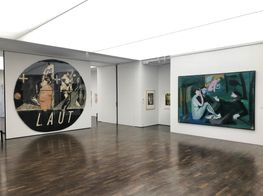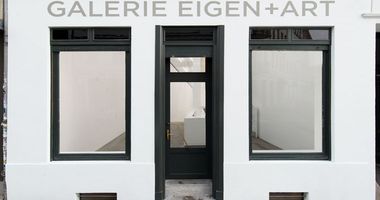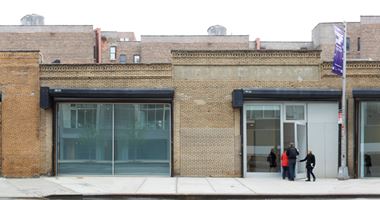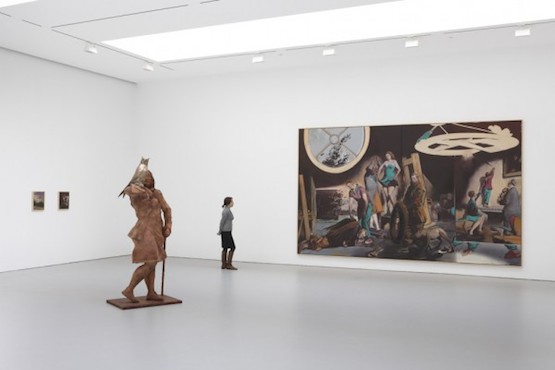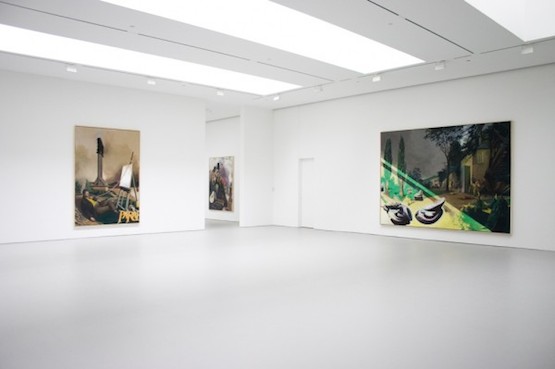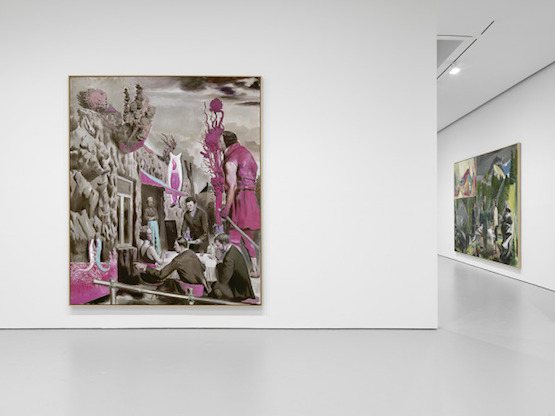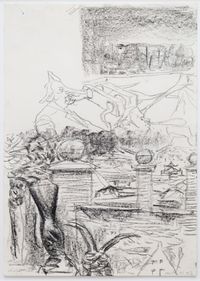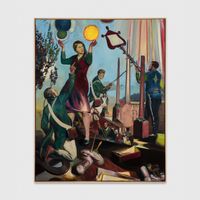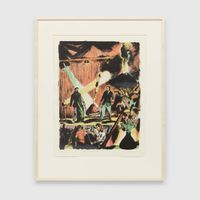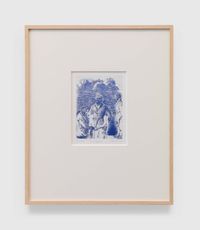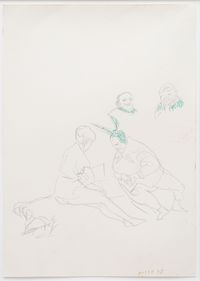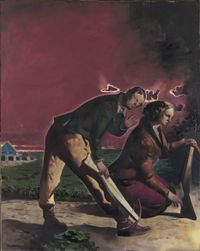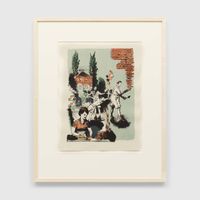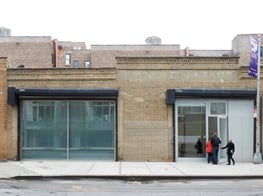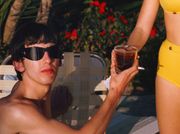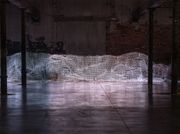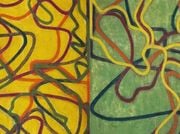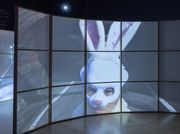Neo Rauch
Neo Rauch. Photo: © Uwe Walter. Courtesy David Zwirner, New York/London
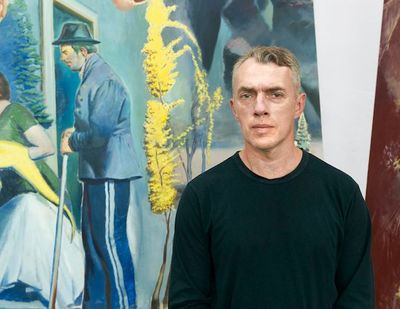
Neo Rauch. Photo: © Uwe Walter. Courtesy David Zwirner, New York/London
Born in 1960 in Leipzig in what was then, East Germany, Neo Rauch is part of a generation of artists who came of age in a war-torn, divided nation. He studied figurative painting at the Hochschule für Grafik und Buchkunst in Leipzig.
When the Berlin wall fell he continued to paint in a representational style, unlike many of his contemporaries, who considered the style outmoded and too akin to state sanctioned Social Realist art. In 1999, Galerie Eigen + Art showed Rauch's work at The Armory Show in New York to great critical acclaim, and New York exhibitions with David Zwirner followed, as did multiple gallery and museum exhibitions in Europe. In 2010, Rauch had his first museum survey, which was jointly held at the Museum der bildenden Kunste in Leipzig, Germany, and the Pinakothek der Moderne, Munich, Germany.
In 2011, a selection of the works from this survey then traveled to the Zachęta National Gallery of Art in Warsaw, Poland. In 2013, he got his first Belgian solo exhibition, Neo Rauch: The Obsession of the Demiurge, at the BOZAR-Centre for Fine Arts in Brussels.
Rauch's work is often associated with both realism and surrealism. His compositions feature people diligently going about their daily activities—a man on a scooter with a child, a woman sculpting, a fishermen gutting a fish—however, the narratives are never succinct, and the figures appear more participants in a dream or fantasy. He disregards scale and often perspective, splices narrative, and dresses his protagonists in theatre like costumes that suggest strange rituals, while placing them collage like against barren landscapes or strange village or industrial backdrops.
Unusually abstraction is also a term applied to Rauch's work, mainly due to his use of colour, which appears to be deployed for composition and effect. In a new and recent development, he has started to use distinct color schemes for his paintings. In Der Felsenwirt, (2014), we see one woman and three men in evening wear gathered at a dining table that is placed outside a stone structure and watched by an "inn-keeper" type character.
The dining figures are unperturbed by the goliath like figure that dwarfs them and walks behind their table, nor the strange lizard like creatures caught in an embrace to their left. The composition is entirely painted in neutrals, other than distinct areas of pink and aqua—the chairs and the goliath like figure, for example—and small touches of purple.
In this interview Neo Rauch discusses his use of colour, theatre costumes and also the relevance of fairytales to his work.
ADYou were born in Leipzig, which is in the eastern part of Germany in 1960 and spent your youth in the German Democratic Republic where you completed your art studies at the Hochschule für Grafik und Buchkunst in Leipzig – Academy of Visual Arts, Leipzig. What motivated you to study art?
NRFor me anything but art was out of question. Drawing enabled me to continue to play so I carried it over to adulthood in order to professionalise it.
ADIn an Artforum article "Last Painting", which was published in 1981 the critic Thomas Lawson argues that painting can be used as an instrument for subversion. To what extent does this statement relate to your work?
NRIf this statement refers to inner painterly processes I can agree: The act of painting seen as a corrector and driving power in the sense of an evolutionary conversion of painterly customs and conventionalities within painting itself. Relating to society, I find painting entirely unsuitable. I would even go as far as to say that it is virtually worthy of protection for and against a utilization of political programmatic.
ADIn a 2002 article, Roberta Smith wrote an article on your works: "Mr. Rauch is developing a distinctive Pop-Surrealist-Social Realist style. Warhol, Léger and Magritte could number among his current interests.
Or he may be trying to rectify Georg Baselitz's early hero paintings with Sigmar Polke and Martin Kippenberger's sense of the absurd, as well as his own more academic background." To what extent was she correct in drawing connections to the artists she referenced?
NROne gets closer to the core of the matter when crossing out Warhol from the list.
ADBefore you begin to paint, do you have a definite vision of the final outcome you wish to achieve?
NRProvided that a vision can ever be concrete it is the most favourable and fortunate starting situation when a phantom of a painting appears before me that I then must re-enact however conscious that I will only get approximate hold of it. It could be a whisper that seeks out to me via conceptions or terminology; it could be a coloristic triad that beams at me from my floor on which I blend my colours; but it could also be a nearly complete, figurative and scenic arrangement that grows out of dark depths and arises before me.
ADIn a previous interview you said that you wanted people to linger before your paintings, and to be rewarded—"if people devote time to the picture than they must be rewarded". What do you hope a viewer takes from your work?
NRThe viewer should absolutely get the feeling that his time is not measured with a ruler but with a scale. Meaning an enrichment of substances in the time through a conveyance of sensations that can gradually be turned into meaning through ones mind. The paintings should appeal to the viewers mind irrespective of their narrative first impression with the creatural implicitness and unintentionality of plants.
ADIn the recent work shown at David Zwirner for At the Well, you used colour schemes for some of the paintings, for example in Der Felsenwirt [The Mighty Rock's Innkeeper] (2014), we see neutrals and hot pinks used predominantly (there is a touch of purple and aqua too). Can you please outline your interest in using colour schemes and why you made this shift?
NRFrom time to time I love incorporating applied art of earlier decades into my painting. The charming misprints of pristine comics for example, which are based on a few printing processes and occasionally suppose an absence of an entire colour have always fascinated me. On that account, I occasionally tend to orchestrate triads that are of dissonant nature and rise to the challenge of legitimising the discordance or rather to make it consumable by means of intense painterly devotion, to domesticate it.
ADThe figures in your paintings often appear as though they were in costumes. Are you able to outline the connection (if any) between your work and theatre?
NROf course, the large formats, which I favor already open up a stage area in which I can boss around personnel that is almost lifesize. So as long as it stays limited to a two-dimensionality, a self-understanding as stage director is not too digressive. However, what remains oddly strange to me is performing and directing in a room.
ADA catalogue was published to accompany your recent exhibition at David Zwirner in New York, At the Well. The catalogue features an essay by the art historian and curator Sir Norman Rosenthal, who presents a careful reading of your new work. In particular, he discusses the relationship between your work and fairy tales. How would you define the relationship between your work and fairy tales?
NRFairy tales for me are a profound romantic phenomenon, which I feel strongly connected to in terms of understanding romanticism as re-enchantment of the world with painterly mediums. According to that, the arc ranges from dark spheres of the pre-enlightenment into a post-modern confusion of a yet unsorted post-enlightenment.
ADYou are a recognised accomplished painter, where does the challenge in painting reside for you today?
NRWho sees me that way and what exactly is meant by 'recognised accomplished painter'? Gottfried Benn says, if something is completed it has to be accomplished. And if I were to apply the term 'completion' to myself I feel scared. It would mean that the prespecified extent of discovery and adventures in painting would be exhausted. This would be a truly tragic result that I hold against with my unabated curiosity for the possibilities of the medium. For me, each blank canvas is a fog bank that I enter equally anxious and excited safe in the knowledge that I will come across things that I have never seen before. —[O]

